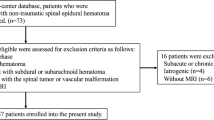Summary
Background. The diagnosis of spontaneous spinal haematomas mainly depends on magnetic resonance imaging. This study evaluates the MRI characteristics of spinal epidural and subdural haematomas. The results were correlated with medical history, coagulation abnormalities and therapeutic outcome to provide guidelines for early diagnosis and treatment of spinal epidural and subdural hematomas.
Summary of Background Data. Imaging signs of epidural and subdural haematomas have been reported before, however without special attention to the differential-diagnostic and therapeutic implications of haematoma localisation.
Method. Seven patients (3 women, 4 men, age range 55–86 years) with acute progressive neurological deficits and without a history of severe trauma were studied. In all cases neurological examinations were performed after admission followed by MRI studies with T2 and T1 weighted images, before and after administration of contrast agent. Spinal angiography was performed twice to exclude a vascular malformation. All patients underwent open surgery.
Findings. Acute and subacute hematomas were detected once in the cervical spine, in five cases in the thoracic region and once in the lumbar region. The hematomas had an epidural location in three cases and a subdural in four. In the thoracic region subdural haemorrhage was much more common than epidural hematomas. Subdural blood collections were mainly found ventral to the spinal cord. Epidural haemorrhage was always located dorsal to the spinal cord. The evaluation of the haematoma localisation may be difficult occasionally, but delineation of the dura is frequently possible in good quality MRI. The clue to the diagnosis of ventrally located subdural haemorrhage is the absence of the “curtain sign”, which is typical for epidural tumours.
Interpretation. Spontaneous spinal hematomas are frequently located in the thoracic spine. Subdural spinal haemorrhage is more frequent than epidural. Epidural haemorrhage is frequently located dorsal to the spinal cord because of the tight fixation of the dura to the vertebral bodies.
Similar content being viewed by others
Author information
Authors and Affiliations
Rights and permissions
About this article
Cite this article
Küker, W., Thiex, R., Friese, S. et al. Spinal Subdural and Epidural Haematomas: Diagnostic and Therapeutic Aspects in Acute and Subacute Cases. Acta Neurochir (Wien) 142, 777–785 (2000). https://doi.org/10.1007/s007010070092
Issue Date:
DOI: https://doi.org/10.1007/s007010070092




